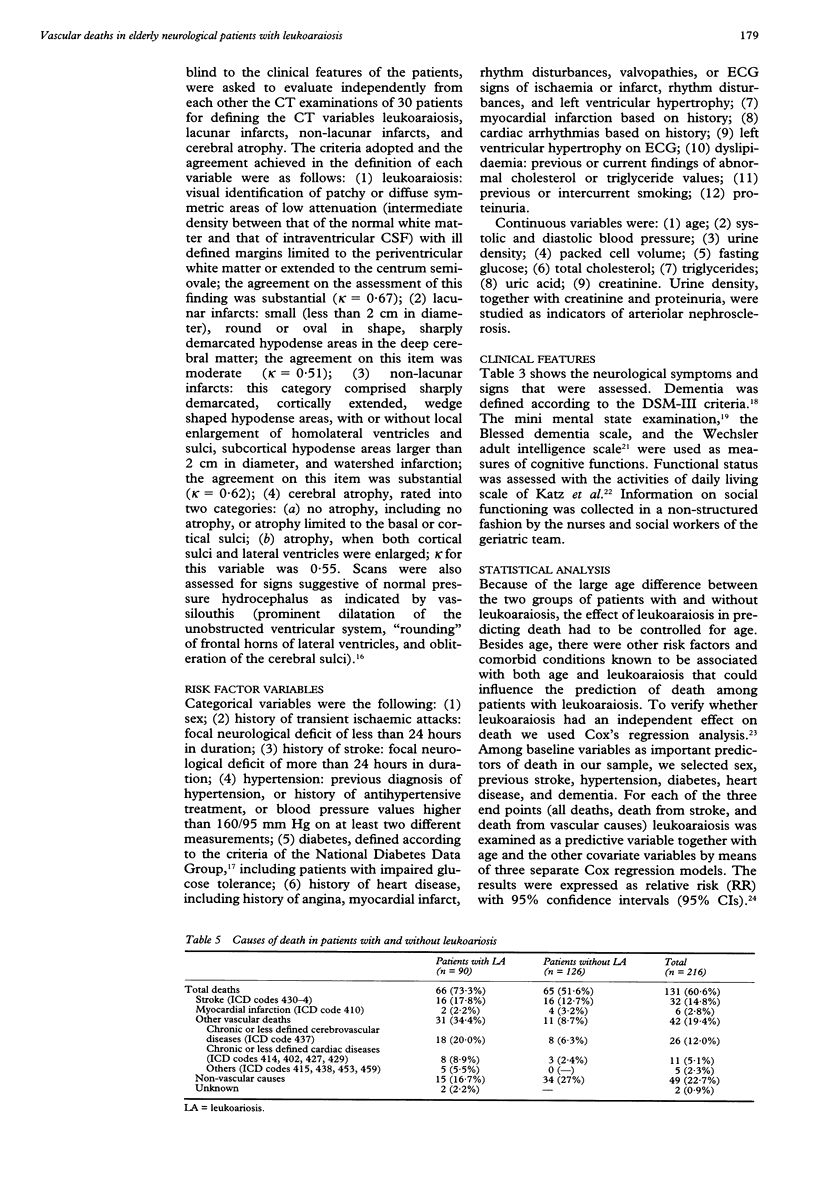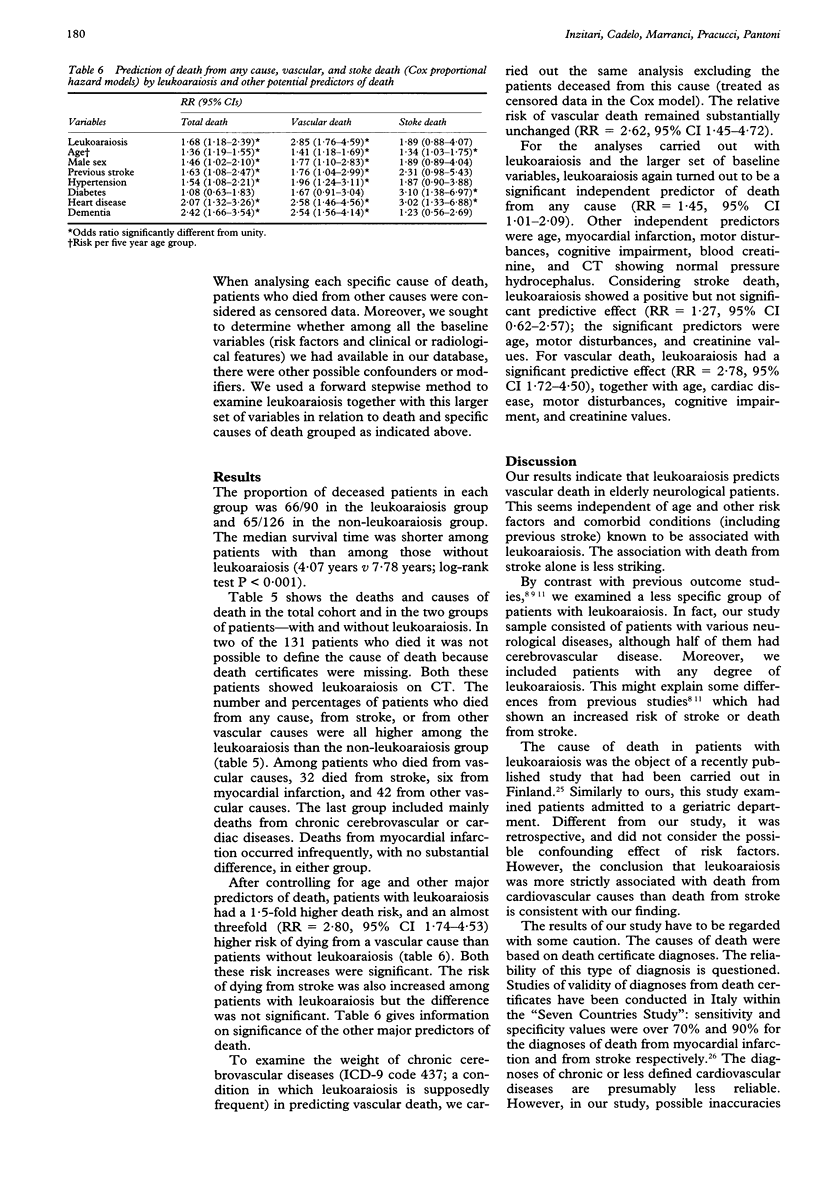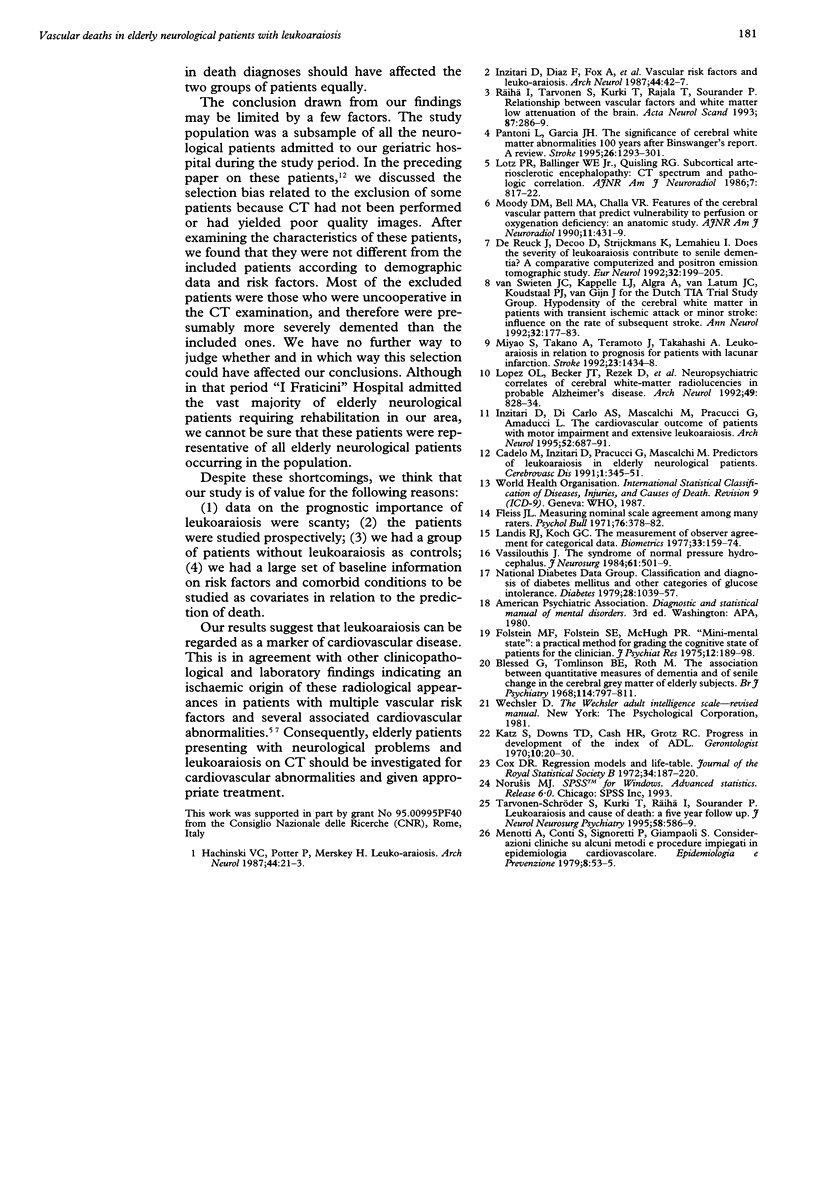Abstract
OBJECTIVES: The prognostic significance of leukoaraiosis is still not completely elucidated. The objective was to examine survival and causes of death among elderly neurological patients with leukoaraiosis. METHODS: From 1 January 1994, vital status and causes of death were drawn from municipality lists and death certificates of 216 patients (mean age (SD) 70.6 (8.3) years) admitted to a geriatric unit who underwent cranial CT between 1 January 1984 and 31 December 1986 (mean observation period (SD) 8.4 (0.8) years). These patients had been enrolled for a study of clinical predictors of leukoaraiosis. Based on the presence of leukoaraiosis on CT, this group had been divided into two subgroups of patients, with and without leukoaraiosis. The difference in survival and causes of death between these groups formed the objective of the study. RESULTS: Survival time was shorter among the 90 patients with leukoaraiosis than among the 126 patients without (median survival time 4.07 v 7.78 years, log rank test P < 0.001). After controlling for age and other major death predictors, the risk of death remained significantly increased (relative risk (RR) = 1.64, 95% confidence interval (95% CI) 1.15-2.34) among patients with leukoaraiosis. Moreover, patients with leukoaraiosis had an almost threefold higher risk of dying from vascular causes than patients without (RR = 2.81, 95% CI 1.74-4.53). CONCLUSION: Leukoaraiosis is a predictor of vascular deaths in elderly neurological patients. Careful diagnostic evaluation and attention to preventive measures are required in patients with leukoaraiosis.
Full text
PDF




Selected References
These references are in PubMed. This may not be the complete list of references from this article.
- Blessed G., Tomlinson B. E., Roth M. The association between quantitative measures of dementia and of senile change in the cerebral grey matter of elderly subjects. Br J Psychiatry. 1968 Jul;114(512):797–811. doi: 10.1192/bjp.114.512.797. [DOI] [PubMed] [Google Scholar]
- De Reuck J., Decoo D., Strijckmans K., Lemahieu I. Does the severity of leukoaraiosis contribute to senile dementia? A comparative computerized and positron emission tomographic study. Eur Neurol. 1992;32(4):199–205. doi: 10.1159/000116822. [DOI] [PubMed] [Google Scholar]
- Folstein M. F., Folstein S. E., McHugh P. R. "Mini-mental state". A practical method for grading the cognitive state of patients for the clinician. J Psychiatr Res. 1975 Nov;12(3):189–198. doi: 10.1016/0022-3956(75)90026-6. [DOI] [PubMed] [Google Scholar]
- Hachinski V. C., Potter P., Merskey H. Leuko-araiosis. Arch Neurol. 1987 Jan;44(1):21–23. doi: 10.1001/archneur.1987.00520130013009. [DOI] [PubMed] [Google Scholar]
- Inzitari D., Di Carlo A., Mascalchi M., Pracucci G., Amaducci L. The cardiovascular outcome of patients with motor impairment and extensive leukoaraiosis. Arch Neurol. 1995 Jul;52(7):687–691. doi: 10.1001/archneur.1995.00540310057017. [DOI] [PubMed] [Google Scholar]
- Inzitari D., Diaz F., Fox A., Hachinski V. C., Steingart A., Lau C., Donald A., Wade J., Mulic H., Merskey H. Vascular risk factors and leuko-araiosis. Arch Neurol. 1987 Jan;44(1):42–47. doi: 10.1001/archneur.1987.00520130034014. [DOI] [PubMed] [Google Scholar]
- Katz S., Downs T. D., Cash H. R., Grotz R. C. Progress in development of the index of ADL. Gerontologist. 1970 Spring;10(1):20–30. doi: 10.1093/geront/10.1_part_1.20. [DOI] [PubMed] [Google Scholar]
- Landis J. R., Koch G. G. The measurement of observer agreement for categorical data. Biometrics. 1977 Mar;33(1):159–174. [PubMed] [Google Scholar]
- Lopez O. L., Becker J. T., Rezek D., Wess J., Boller F., Reynolds C. F., 3rd, Panisset M. Neuropsychiatric correlates of cerebral white-matter radiolucencies in probable Alzheimer's disease. Arch Neurol. 1992 Aug;49(8):828–834. doi: 10.1001/archneur.1992.00530320052012. [DOI] [PubMed] [Google Scholar]
- Miyao S., Takano A., Teramoto J., Takahashi A. Leukoaraiosis in relation to prognosis for patients with lacunar infarction. Stroke. 1992 Oct;23(10):1434–1438. doi: 10.1161/01.str.23.10.1434. [DOI] [PubMed] [Google Scholar]
- Moody D. M., Bell M. A., Challa V. R. Features of the cerebral vascular pattern that predict vulnerability to perfusion or oxygenation deficiency: an anatomic study. AJNR Am J Neuroradiol. 1990 May;11(3):431–439. [PMC free article] [PubMed] [Google Scholar]
- Pantoni L., Garcia J. H. The significance of cerebral white matter abnormalities 100 years after Binswanger's report. A review. Stroke. 1995 Jul;26(7):1293–1301. doi: 10.1161/01.str.26.7.1293. [DOI] [PubMed] [Google Scholar]
- Räihä I., Tarvonen S., Kurki T., Rajala T., Sourander L. Relationship between vascular factors and white matter low attenuation of the brain. Acta Neurol Scand. 1993 Apr;87(4):286–289. doi: 10.1111/j.1600-0404.1993.tb05509.x. [DOI] [PubMed] [Google Scholar]
- Tarvonen-Schröder S., Kurki T., Räihä I., Sourander L. Leukoaraiosis and cause of death: a five year follow up. J Neurol Neurosurg Psychiatry. 1995 May;58(5):586–589. doi: 10.1136/jnnp.58.5.586. [DOI] [PMC free article] [PubMed] [Google Scholar]
- Vassilouthis J. The syndrome of normal-pressure hydrocephalus. J Neurosurg. 1984 Sep;61(3):501–509. doi: 10.3171/jns.1984.61.3.0501. [DOI] [PubMed] [Google Scholar]
- van Swieten J. C., Kappelle L. J., Algra A., van Latum J. C., Koudstaal P. J., van Gijn J. Hypodensity of the cerebral white matter in patients with transient ischemic attack or minor stroke: influence on the rate of subsequent stroke. Dutch TIA Trial Study Group. Ann Neurol. 1992 Aug;32(2):177–183. doi: 10.1002/ana.410320209. [DOI] [PubMed] [Google Scholar]


